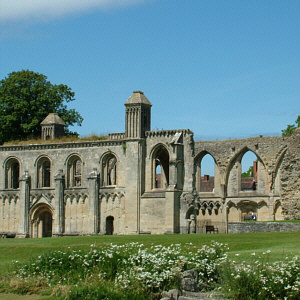According to Wikipedia and many other online sources the origin of the name Glastonbury is unclear. On the contrary, it could not be more clear.
While idly thinking about a long-ago visit to Glastonbury Tor I chanced to reflect on the name Glastonbury. What, I wondered, was the true etymology of the name. The 'witrin' in the old Celtic name Ynys Witrin seemed to me to resemble the Latin term for glass. The modern Welsh equivalent 'ynys gwydr' means 'glass island'. Could the 'glas' of Glastonbury mean glass? What then of 'ton', which so often means 'town'. Surely the name should be Glaston or Glasbury. Why the apparent redundancy?
If 'ton' is a variant of 'tone', meaning color, then might 'Glastonbury' mean glass-coloring town?
A Google search for a link between glass and Glastonbury turned up an interesting item: this abstract from Cambridge Journals supports the idea of 'glass town'.
The Origin of the Name of Glastonbury
Louis H. Gray
Cabadoc of Llancabvan (sic), writing his biography of Gildas about the middle of the twelfth century, endeavors thus to explain the origin of the name of Glastonbury(§§10,14):
Glastonia, id est Urbs Vitrea, quae nomen sumpsit a vitro, est urbs nomine primitus in Britannico sermone. … Ynisgutrin nominata fuit antiquitus Glastonia et adhuc nominatur a Britannis indigenis; ynis in Britannico sermone insula Latine; gutrin vero vitrea. Sed post adventum Angligenaxum et expulsis Britannis, scilicet Walensibus, revocata est ex ordine primi vocabuli, scilicet glas Anglice vitrum Latine, beria civitas, inde Glastiberia, id est Vitrea Civitas.
My loose translation of the Latin reads:
Glastonbury, that is Glass City, which is the name it took from the glass, is a city originally named Ynisgutrin by the indiginous people. It was named Glastonbury in former times and is still thus named by the British; ynis in the British tongue, insula in Latin; gutrin is glass. But after the coming of the Angles and the expulsion of the Britons, that is, the Welsh, English was adopted for the first part of the name, namely, glass, and Latin beria, a city, and thus we have Glastiberia, that is, the glass city.
Caradoc of Llancarfan makes no mention of the 'ton' part of the name, so my next voyage of scientific discovery was a search for any evidence that ancient Glastonbury might have been a center for the manufacture of colored glass. A fresh Google search revealed that Glastonbury is Britain's oldest known glass-making site. And yes - there is at least some supporting evidence to suggest that Glastonbury, or at least Glastonbury Abbey, might once have been known for its colored glass.

Glastonbury Abbey
The paper Late Seventh-Century Glassmaking at Glastonbury Abbey published in the Journal of Glass Studies, vol 55, 2013 reports on carbon dating of finds from the 1950s.
A number of charcoal samples from within the structures excavated in 1955 were identified, and five of these were selected for radiocarbon dating. Together,they provide a broad date of 605–882, but when the ranges of overlap are considered, a date in the late seventh century, and the 680s in particular, can be assumed.The paper reports finds of blue-green, olive, amber and turquoise glass, also a piece of opaque white and turquoise reticello rod. Also, "A little more than 200 fragments (92 percent) of the fully formed glass are blue-green, although many fragments have additional colors as surface treatments."
This date is particularly significant because it places the operation of the glass furnaces in the earliest phase of known monastic activity at Glastonbury, coinciding with the reign of King Ine of the West Saxons, who founded the monastery sometime shortly after his accession in 688.
Given this association, it can reasonably be concluded that the glassmaking operation was specifically established to provide window glass for the newly constructed buildings of the abbey, as well as vessel glass for use by the members of the religious community.
The evidence for 'color' is quite literally fragmentary. However, it is known from the writings of the Venerable Bede that glass workers came from France to Britain in the relevant historical period. The old French word for 'tone' is the same as the modern French - 'ton'. But it can also mean 'stretch'. One method of working with glass is to stretch it so as to make rods and strings for, e.g. reticello. Could this be a long-lost medieval French pun on the coloring and stretching of glass. Anyone for Glass-pun- bury?
Conclusion
There is evidence of what was at the time in question quite a large scale of glass making or glass working in Glastonbury. In the French language, our 'tone' is 'ton'. It appears, then, that the name 'Glastonbury', far from being obscure, may well mean Glass-coloring-borough.
.
.




Comments